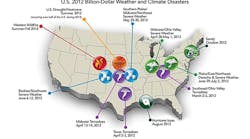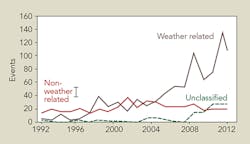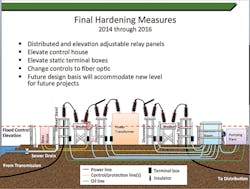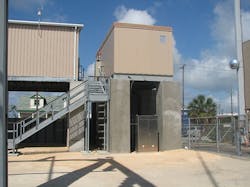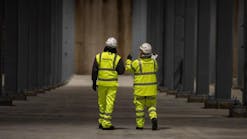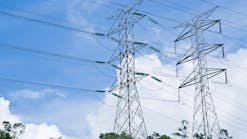Are extreme weather events becoming an increasing threat to utilities? The U.S. federal government believes they are.
In August 2013, the executive office of the president issued the “Economic Benefits of Increasing Electric Grid Resilience to Weather Outages” report, which warns: “Grid resilience is increasingly important as climate change increases the frequency and intensity of severe weather. Greenhouse gas emissions are elevating air and water temperatures around the world. Scientific research predicts more severe hurricanes, winter storms, heat waves, floods and other extreme weather events being among the changes in climate induced by anthropologic emissions of greenhouse gases.”
The power industry is gearing up like never before to battle storms. Careers in this industry are sure to be impacted as utilities, regulators and the general public agree that no one wants to suffer ever again the massive outages caused by the disastrous weather events of the last two decades.
Outages Hammer the U.S. Economy
The report from the executive office of the president goes on to state that, depending on assumptions, weather-related outages cost the U.S. economy $25 billion to $70 billion annually. Hurricane Andrew in 1992 was the costliest hurricane in U.S. history up to that time. Then Katrina in 2005 and Ike in 2008 got our attention. Finally, Hurricane Irene in 2011 and Superstorm Sandy in 2012 spurred coastal utilities and their regulators to take action.
Not only do hurricanes impact utilities, but tornadoes, ice storms and wildfires also can cause outages. And it looks like things are getting worse, at least the U.S. Department of Energy (DOE) thinks so.
According to the DOE, the number of outages resulting from extreme weather is expected to rise as climate change increases the frequency and intensity of hurricanes, blizzards, floods and other extreme events. In 2012, the U.S. experienced 11 weather disasters that exceeded $1 billion in damages. This was the second worst year for weather disasters on record, second only to 2011.
Still, there is no general scientific consensus that hurricanes or tornadoes have increased in frequency or intensity during the last decade. The increasing storm-caused outages are primarily a result of storms hitting just the right coastal spots to cause maximum damage. But, scientific consensus means little when customers are in the dark and cold, and the media makes sure everyone else sees the disaster and misery in living color.
Ratepayers, regulators and government are all saying, “Fix it now!” And some major utilities are busy preparing for what has been called the “new normal.”
Willing to Pay More
According to a recent Harris Poll on behalf of GE, 41% of Americans living east of the Mississippi River are willing to pay an additional $10 per month to ensure the grid is more reliable; that’s compared to 34% of those living west of the Mississippi.
The survey also found 50% of U.S. adults believe natural disasters and weather-related events are the greatest threat to the U.S. power grid. No doubt because of recent storms, 61% of adults in the Northeast region believe weather is the greatest threat to the grid compared to 48% in the South and Midwest, and 43% in the West.
“Natural disasters such as Superstorm Sandy, Hurricane Irene and the recent polar vortices highlighted the challenges utilities face providing power to meet high energy demand,” said John McDonald, director of technical strategy and policy development for GE’s Digital Energy business. “They also revealed the reliability challenges utilities experience when the U.S. electrical grid is under extreme stress.”
Con Edison’s Storm-Hardening Strategy
On Oct. 29, 2012, Superstorm Sandy hit New York City. The storm surge flooded streets, tunnels and subway lines, and cut power in and around the city. Sixty percent of 345-kV transmission was lost. As a result, 1.1 million Con Edison customers lost power.
Although Sandy was the worst weather disaster to hit Con Edison, it was not the first. Was this the beginning of a trend?
“After Sandy landing on the heels of Irene, we’ve had four of our top five storms in a three-year period,” said Matthew Sniffen, chief engineer of regional engineering at Con Edison. “So we’ve certainly been asking ourselves, ‘Is this the new normal?’ Our stakeholders have been telling us that it is, so we’re heading in the direction of preparing for it.”
Andy Tiao, director of emergency management at Con Edison, believes the best way to start is to learn from the experience of others. “We’re benchmarking with a number of utilities and other companies,” said Tiao. “We learned a lot from seeing how Florida Power & Light prioritized its storm-hardening efforts following hurricanes in 2004 and 2005. We’ve also learned a lot from Connecticut Light & Power. And, of course, because our customers experienced the full brunt of Hurricanes Irene and Sandy, we’re doing our best to share what we’ve learned.”
That’s putting it mildly. Con Edison is in the second year of a four-year, $1 billion program to protect New Yorkers from the next major storm. “All new equipment to be located in the flood zone is submersible, and all new customers are required to have their connections above grade,” Sniffen explained. “Of course, we’re making sure that distribution assets added to meet our growing load are coordinated with the storm-hardening strategies.”
Although the outages in Manhattan were prominent in the news, Con Edison’s 34,000 miles (151,278 km) of overhead lines suffered severe damage from Hurricane Irene and Superstorm Sandy. Earlier storms, though smaller in scale, also were devastating, including snowstorms in 2010 and 2011, and a nor’easter in 2011. In each of these storms, extensive damage caused by downed trees and windblown tree limbs delayed complete restoration for a week or more.
The utility’s overhead hardening strategy includes major network redesign to reduce the number of customers affected by a line-damaging event. Con Edison is reducing feeder segment size, adding isolation devices on open-wire spurs and improving auto-loop design by allowing power to be fed from both ends as well as from other points along the feeder circuit.
Con Edison is also beefing up major overhead line components. For example, poles in storm-prone areas will be required to withstand gusts up to 110 mph (177 kmph). The utility is considering using Hendrix aerial cable to replace open-wire design and is piloting sacrificial components, such as breakaway hardware and detachable service cable.
PSE&G’s Focus on Stronger, Smarter Systems
PSE&G, the largest utility in New Jersey, has been named the most reliable utility in the country five of the past eight years, but that standard of excellence did not prevent the utility from being thoroughly hammered by recent storms. In 2011, Hurricane Irene knocked out power to more than 850,000 electric customers. A month later, a wet, heavy snow brought down numerous trees and power lines, leaving 500,000 customers without power. A year later, Superstorm Sandy came along and left 2 million PSE&G customers without electricity.
“These recent weather patterns led us to propose a rethinking of our infrastructure and systems, even though our current assets provide recognized, award-winning reliable service,” said Richard Wernsing, PSE&G’s manager of electric asset strategy.
That rethinking has resulted in a $1.2 billion program to make PSE&G’s gas and electric systems stronger and smarter. This five-year hardening program includes station flood and storm-surge mitigation, more robust line design standards, use of composite and other non-wood poles, and the undergrounding of 20 miles (32 km) of overhead line.
CenterPoint Takes a Lofty View
The ravages of Superstorm Sandy brought attention to the East Coast. However, the Gulf Coast has had more hurricane events. Katrina caused the largest number of outages, but Hurricanes Gustav and Ike landed within two weeks of each other in September 2008. The two storms caused millions of electricity customers to lose power as thousands of miles of transmission and distribution lines and hundreds of substations were disabled, and two nuclear power plants shut down.
Serving a 5,000-sq-mile (12,950-sq-km) service area around Houston, Texas, CenterPoint Energy is no stranger to storms. CenterPoint Energy learned from its experience with Hurricane Alicia in 1983 and Hurricane Rita in 2005. Still, when Hurricane Ike landed, CenterPoint Energy’s electric delivery system took a direct hit, resulting in the largest power outage in Texas history. More than 95% of its electric delivery customers lost power: 2.15 million at the storm’s peak.
“After Hurricane Ike hit us, we found that a number of our control houses had 4 ft to 5 ft (1.2 m to 1.5 m) of water inside,” said Chester Kowalik, senior consulting engineer at CenterPoint Energy. “As a result, we’ve begun to elevate our control houses to alleviate flooding during storm surge. In most cases, we’re raising them to about 22 ft (6.7 m) above sea level. That puts them at about 15 ft (3 m) above the ground. We’re also elevating some large autotransformers and all control cable connections above the floodplain.”
What About Transmission Structures?
“Compared to other coastal utilities, we had few transmission lines blown down during Hurricane Ike,” said CenterPoint’s Kowalik. “That’s because we had designed for expected highest storm wind speeds. However, many of our wood poles don’t meet new design standards, and we’re replacing them with either steel or concrete.”
Some major Gulf electric customers have used storm-hardening technology for years. An example is the Galveston campus of Texas A&M University, located on Pelican Island, with an approximate 13-ft (4-m) elevation. The campus has used 14 Thayer stainless-steel submersible padmount switches successfully since the 1980s, even during Ike’s 100-mph (161-kmph) winds, 22-ft (6.7-m) storm surge and resulting debris field.
Other Utilities are Beefing Up
In June 2012, a derecho raced across a large section of the Midwestern U.S., through the central Appalachians and into the Mid-Atlantic states. It resulted in 22 deaths and more than 4 million people without power. A derecho is a rapidly moving line of intense thunderstorms that produces very high straight-line winds.
Even utilities on the relatively mild West Coast are taking a close look at their vulnerability to potential storms. For example, Los Angeles Department of Water and Power has a comprehensive hardening approach that includes improved designs for wind and fire resistance, anti-corrosion techniques, and the use of upgraded materials and practices that exceed state and local standards.
In Northern California, PG&E has benchmarked its storm preparedness against several other utilities and is continuing to develop a comprehensive strategy.
Green Can Be Mean
A large percentage of outages are caused by falling trees, windblown branches and lightning-caused fires. Following the recent string of unprecedented storms, some utilities are re-examining their vegetation management policies. For example, Con Edison has begun identifying hazard trees rooted outside of normal maintenance boundaries and is working with landowners to find agreeable solutions, including removal. The utility also created new clearance standards.
Fortunately, just as recent storms have created mandates for hardening the electrical grid, new rules are being put in place for managing nearby vegetation. In the eastern U.S., Massachusetts, Connecticut, New Jersey, Maryland and West Virginia are adopting strong vegetation management rules aimed at reducing outages. We can expect these new standards will spread to Western utilities along with new electric asset-hardening practices.
Between Storms
Will the storm-hardening strategies really work? The industry will have to wait for another major storm to find out. However, at least one East Coast utility found that a tougher line design can make all the difference.
Less than 50 miles (80 km) northeast of Manhattan on Long Island Sound, Third Taxing District (TTD), the municipal utility of Norwalk, Connecticut, also faced Sandy’s fury.
“We literally had boats floating down the streets of Norwalk,” said Jim Smith, TTD’s general manager. Despite the winds and flooding, and the experiences of neighboring utilities, more than 30% of TTD customers never lost power.
“We already had a tight, hardy 4-kV overhead feeder system using mostly Hendrix heavy cable,” Smith explained. “Using 4 kV rather than, say, 13 kV, gives us fewer insulator problems, and downed tree branches don’t burn on the lines. These lines give us very high reliability during normal times. And we were very pleased to see them stand up against Sandy.”
Con Edison also is finding it does not have to wait for the next storm to reap benefits from hardening the system. “The post-Sandy storm-hardening improvements are paying service reliability dividends for our customers,” said Robert Schimmenti, vice president of engineering and planning. “Devices installed on our overhead system isolate damage on our lines so that, when outages occur, fewer customers are affected.”
The utility is in the early days of its ambitious $1 billion storm-hardening program. Still, by August 2014, post-Sandy storm-hardening improvements had spared customers 20,000 outages so far in the year.
Managing Expectations and Perceptions
The threat of increasing storm frequency and severity no doubt will lead to tougher, more resilient power systems. Ironically, as TTD’s Smith points out, higher overall reliability will present a new challenge. “There is a downside to having a tight, highly reliable system,” Smith cautioned. “Customer expectations become unreasonably high, and when you do have a major event with unavoidable outages, no matter how few, it will be highly publicized.”
The Florida Hurricane Story
By Richard Brown, Exponent
The Florida hurricane story began in 1992, when Hurricane Andrew struck southern Florida with Category 5 devastation. More than 150,000 homes were destroyed or damaged, and about 1.4 million people experienced extended loss of electricity service.
In the wake of Andrew, extensive claims resulted in 11 insurance carriers going bankrupt, causing hurricane insurance premiums to skyrocket or not to be offered at all. Since utilities could no longer get hurricane insurance for their T&D systems, the Florida Public Service Commission allowed them to establish storm reserve accounts to pay for future hurricane costs. Any storm costs in excess of accrued reserves would be recovered through commission hearings.
Fast-forward 12 years to 2004. This was a very active tropical storm season in Florida, including Hurricanes Charley, Frances, Jean and Ivan. Utility workers in Florida worked tirelessly to restore power to customers with each successive storm, and utilities were largely applauded for their efforts. Power system restoration costs for these hurricanes significantly exceeded utility storm reserves, resulting in storm cost-recovery hearings that received little public attention.
All might have been well had Florida had a break from severe weather in 2005. This was not to be. Hurricanes Katrina and Wilma both resulted in extensive damage to electricity infrastructure, with Wilma, in particular, causing millions of customers to lose power, many for more than two weeks.
After two consecutive extreme hurricane years, many customers were understandably frustrated.
Whereas utilities were portrayed heroes in 2004, they were portrayed as profiteering evil corporations in 2005. Newspapers attacked utilities for having rotten poles, insufficient maintenance, inadequate tree pruning and waiting for hurricanes to wipe out neglected infrastructure so equipment replacement costs could be separately recovered. What a difference a year can make.
The 2005 storm cost-recovery hearings were quite contentious compared to 2004. Word was out the utilities would be passing on approved storm costs to customers, and some felt less damage would have occurred and restoration costs would have been lower if the utilities were properly maintaining their system. Even the Attorney General Charlie Crist (then considering a run for governor) intervened on behalf of the people of Florida. The auditorium-sized hearing room was standing room only, consistently packed with reporters and organized groups such as retirees wearing matching AARP T-shirts.
Besides cost recovery, these hearings addressed two additional issues. First, all regulated electric utilities in Florida were required to submit a storm-hardening plan. These plans should strengthen infrastructure so less damage occurs during hurricanes, restoration takes less time and restoration costs are lower. Second, the utilities were instructed to collaborate with Florida universities to investigate the costs and benefits of overhead-to-underground conversion.
The undergrounding question seems to come up after every major weather event anywhere in the U.S. The costs and benefits of undergrounding have been studied ad nauseum, but no matter. All of the Florida electric utilities, coordinated by the Public Utility Research Center out of the University of Florida, performed an exhaustive literature review, examined several Florida case studies, and developed a hurricane-simulation model capable of examining the costs and benefits of various storm-hardening approaches, including undergrounding.
As with previous studies, this research showed widespread undergrounding is not cost-effective and can actually make things worse in coastal areas subject to storm surge.
The Florida research did show targeted hardening can be cost-effective. For example, a utility could harden critical structures they really do not want coming down during a hurricane. This could be because it is difficult, timely or costly to repair. Damage to these critical structures also could be disruptive to the overall restoration process, such as downed power lines on highways or the loss of power to critical facilities like hospitals and police stations.
A good case study in system hardening is Florida Power & Light (FPL). Since 2006, FPL has invested nearly $1.5 billion to strengthen its T&D system and make it more storm resilient. This includes the following:
• Strengthening more than 450 feeder mains serving critical community facilities such as hospitals, police stations, fire stations and emergency communications systems
• Inspecting more than 1 million poles, and upgrading or replacing more than 95,000
• Clearing vegetation from more than 100,000 miles (160,934 km) of power lines.
FPL also added flood monitors and storm-resistant doors and windows to more than 200 substations (thanks to Hurricane Sandy for the heads up). As a side benefit, FPL has found its storm-hardening efforts have improved normal-weather reliability, as well.
Now it is 2014, a full decade since the 2004 and 2005 hurricane seasons — after vast amounts of money have been spent on system hardening — and not a single major hurricane has made landfall in Florida since then. However, utilities in Florida have stayed the course knowing future hurricanes are not a matter of “if” but “when.”
This commitment to system hardening is challenging because utilities tend to focus on news-of-the-day issues and because multi-year infrastructure investment programs are inherently difficult to sustain within the typical utility budgeting and ratemaking processes. Still, the Florida story shows significant storm hardening is possible. It just might take an initial Category 5 hurricane followed by back-to-back multi-hurricane years to convince everyone that this is the right thing to do.
IEEE Provides a Super Forum
IEEE Power and Energy Society (PES) has stepped up to the plate to bring industry-wide awareness to the need for better storm hardening and response. The IEEE General Meeting held in July 2014 in National Harbor, Maryland, U.S., included a super session on this issue.
A significant portion of this article was obtained from listening to experts from regional transmission organizations, independent system operators, utilities, vendors, consulting companies and academia. Presenters discussed natural disaster planning and restoration, infrastructure hardening and system resiliency through strategic asset management, micro grids and new decision support technologies.
Presentations by Jorge L. Cardenas, vice president, asset management and centralized services, and Richard Wernsing, Public Service Electric and Gas Co. (PSE&G) manager, electric asset strategy, were of particular interest. PSE&G has developed its comprehensive Energy Strong program of hardening and resiliency improvements based on the utility’s recent experiences with Hurricanes Irene and Sandy, and a severe snowstorm.
Coming from a manufacturer’s perspective, Gary Rackliffe, ABB North American vice president of smart grids, gave a very thoughtful presentation on hardening the grid for reliability and resiliency.
